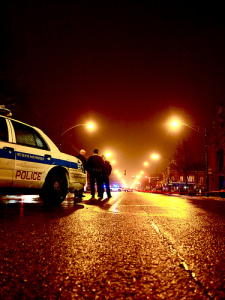A Chicago man was recently charged for the alleged assault and robbery of his mother’s elderly landlady. The robbery occurred shortly after the defendant’s mother paid rent for the month.
Question of Identification in Robbery
In this particular case the victim was allegedly robbed by two men, the defendant and an as yet to be determined co-offender. The defendant allegedly grabbed the victim around the neck and covered her mouth, presumably to prevent her from crying out for help. The robbery occurred outside the apartment building.
There is an immediate question of whether the victim properly identified the defendant as her assailant. The victim was grabbed from behind, and with the hand over her mouth was unlikely able to turn her head to see who had grabbed her. Following the robbery she was pushed to the ground. Reports indicate that the fall caused nerve pain and made her unable to move her legs, so it is also unlikely she was able to turn to get a good look at her assailants as they fled.
Thus, it is quite possible that, injured and most likely extremely shaken-up over the assault, she described the defendant to the police and later identified him in a lineup as the assailant not because he actually committed the crime, but she had seen him shortly before the assault and was therefore the most recognizable.
Careful attention then would need to be paid to the circumstances surrounding the police lineup and whether they influenced the victim in any way. Factors that would tend to show that the police unduly influenced the victim’s description of the perpetrator, and thus would invalidate her identification, include:
- Whether law enforcement asked leading questions when obtaining a description of the assailants, such as specific questions about his physical characteristics;
- Whether the non-suspects included in the lineup of similar coloring, height and build as the defendant;
- Whether law enforcement asked the victim to specifically take a look at the defendant, or to check him out again if she did not immediately select him;
- Whether law enforcement took any other action or made any other statements that drew more attention to the defendant than the other people in the lineup.
Examination of Injuries Sustained in Assault
The victim allegedly suffered a bulging disc, nerve pain and an inability to move her legs following the assault and robbery. Although the degree of the injuries suffered does not increase the charge, it could have a huge impact on the jury. The victim is 68 years old, which will likely make her extremely sympathetic in the eyes of the jury. The more injuries she suffered during the assault, the more likely the jury is to view the defendant in an unfavorable light for assaulting who they perceive as a poor, defenseless little old lady.
It is therefore important to have a medical forensic expert review the victim’s medical records to determine if the injuries she suffered were consistent with the actions taken in the assault. It is also important to review her prior medical records to determine if she has a pre-existing condition that could have caused the nerve pain and bulging disc flare up as a result of the assault, as opposed to being the cause of the injuries. Continue reading
 Chicago Criminal Lawyer Blog
Chicago Criminal Lawyer Blog










